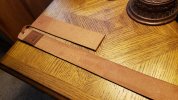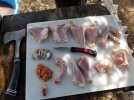View attachment 1150329 You can buy or make owl houses if you like to have them around. Not my photo.
-
The BladeForums.com 2024 Traditional Knife is available! Price is $250 ea (shipped within CONUS).
Order here: https://www.bladeforums.com/help/2024-traditional/
You are using an out of date browser. It may not display this or other websites correctly.
You should upgrade or use an alternative browser.
You should upgrade or use an alternative browser.
Farm Life
- Thread starter David Martin
- Start date
David Martin
Moderator
- Joined
- Apr 7, 2008
- Messages
- 19,520
It rained during the night and was cool this morning. Plus, our Austerlorps are delivering peewees so, I processed 2 of the old layers using Buck's screwed together frame 110. The handle gives a solid grip no matter what you've been handling. The blade went right on cutting and with these chickens being old I had to actually skin them using the knife. Not merely pull the hide off. So, age matters. After finishing it had about 2" of burr on the edge. I went ahead and stropped this off which took no more than 3-4 minutes. Now, if I was not doing this the steel would process maybe 4-5 old birds and likely 6 young birds. There's your numbers.
Still, how many people raise and process 6 fed out young birds a year? By the time I have culled out these old layers I will have put 11 in the freezer. If you plan on using a 110 with this steel for a big cutting job (i.e. a buck) it would be a good idea to have on hand a small leather strop w/ slurry applied to strop on or a 4"X 4" stone that you could back hone on to get you through the job. Thanks, DM
Still, how many people raise and process 6 fed out young birds a year? By the time I have culled out these old layers I will have put 11 in the freezer. If you plan on using a 110 with this steel for a big cutting job (i.e. a buck) it would be a good idea to have on hand a small leather strop w/ slurry applied to strop on or a 4"X 4" stone that you could back hone on to get you through the job. Thanks, DM
David Martin
Moderator
- Joined
- Apr 7, 2008
- Messages
- 19,520
A good question. It is when the cutting edge of the knife has been weakened from use and curls. They can be felt by moving your thumb from the spine downward onto the edge with little pressure. It feels like curled metal at the edge. These area have to be
cleaned up (straightened) or the edge won't cut at that spot. One can see them in bright light, edge up looking down on the edge. They look like shiny areas. Many factors cause them, cutting bone, dragging the blade over the cutting board, torquing the blade during use, ect..DM
cleaned up (straightened) or the edge won't cut at that spot. One can see them in bright light, edge up looking down on the edge. They look like shiny areas. Many factors cause them, cutting bone, dragging the blade over the cutting board, torquing the blade during use, ect..DM
The resistance of an edge to rolling should correlate directly with its Rockwell hardness if other variables like bevel angle were held constant. It would be great if Buck offered loose premium blades for this model. A D-2 blade at 62HRC could improve performance at reasonable cost.
David Martin
Moderator
- Joined
- Apr 7, 2008
- Messages
- 19,520
It is common for Professional meat cutters to straighten the burrs on their knife by steeling it. This will do it. Even a brass rod will do it. However, this burr or curling is still weakened metal and will flop back and forth until it falls off. All a normal result of cutting.
One could remove this by using the slurry on a good muddy stone or with a strop. I would stay away from a hard, smooth stone. DM
One could remove this by using the slurry on a good muddy stone or with a strop. I would stay away from a hard, smooth stone. DM
David Martin
Moderator
- Joined
- Apr 7, 2008
- Messages
- 19,520
One would think so but I have done this and it can remain as fatigued metal. Even stropping on leather with slurry applied can
flop the burr from side to side several times before it is sheered off. I get the best results from stropping it on a rough area of leather with light passes. This seems to grab it and tear it away. Once done the edge cuts crisp and clean for sometime before
requiring this again. DM
flop the burr from side to side several times before it is sheered off. I get the best results from stropping it on a rough area of leather with light passes. This seems to grab it and tear it away. Once done the edge cuts crisp and clean for sometime before
requiring this again. DM
David Martin
Moderator
- Joined
- Apr 7, 2008
- Messages
- 19,520
You should try a decent strop. DM
- Joined
- May 13, 2019
- Messages
- 8,209
Do you make and sell these. They look goodA good stropping never hurt anyone.View attachment 1153262

- Joined
- Oct 17, 2015
- Messages
- 11,465
I've made some, pretty easy to do. Haven't really sold them. Lots of sheaths though,Do you make and sell these. They look good
- Joined
- Mar 6, 2009
- Messages
- 2,243
Enlighten me. The steel will bring it back to shaving with a few strokes, to me if it shaves the hair on my arm thats sufficient, or am i missing something.You should try a decent strop. DM
David Martin
Moderator
- Joined
- Apr 7, 2008
- Messages
- 19,520
^ What I'm saying is a strop works different than a steel. A steel flexes thin metal, straight or off the apex. Whereas a strop grabs
it and peels it off the apex. Plus, a strop is very portable. DM
it and peels it off the apex. Plus, a strop is very portable. DM
Last edited:
David Martin
Moderator
- Joined
- Apr 7, 2008
- Messages
- 19,520


